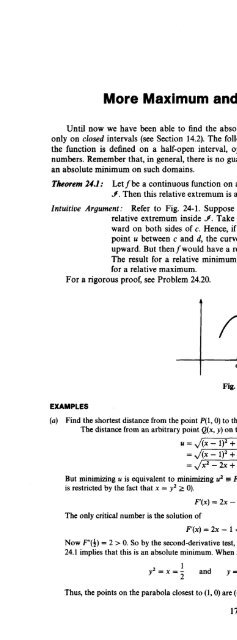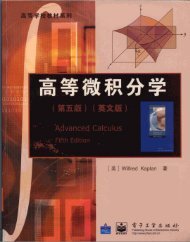- Page 4:
To the memory of my father, Joseph,
- Page 8:
This page intentionally left blank
- Page 12:
6.2 Symmetry about a Point 42Chapte
- Page 16:
Chapter 18Rectilinear Motion and In
- Page 20:
Chapter 32Applications of Integrati
- Page 24:
This page intentionally left blank
- Page 28:
2 COORDINATE SYSTEMS ON A LINE[CHAP
- Page 32:
~ ~ ~4 COORDINATE SYSTEMS ON A LINE
- Page 38:
CHAP. 11COORDINATE SYSTEMS ON A LIN
- Page 42:
CHAP. 23COORDINATE SYSTEMS IN A PLA
- Page 46:
CHAP. 21 COORDINATE SYSTEMS IN A PL
- Page 50:
CHAP. 2) COORDINATE SYSTEMS IN A PL
- Page 54:
CHAP. 31GRAPHS OF EQUATIONS15T0 0-1
- Page 58:
CHAP. 3) GRAPHS OF EQUATIONS 17on c
- Page 62:
CHAP. 31 GRAPHS OF EQUATIONS 193.5
- Page 66:
CHAP. 31 GRAPHS OF EQUATIONS 21x2 y
- Page 70:
CHAP. 31 GRAPHS OF EQUATIONS 233.16
- Page 74:
CHAP. 41 STRAIGHT LINES 25EXAMPLE I
- Page 78:
CHAP. 41STRAIGHT LINES274Ym =O m =O
- Page 82:
CHAP. 41AYSTRAIGHT LINESt’29Fig.
- Page 86:
CHAP. 41 STRAIGHT LINES 31Represent
- Page 90:
CHAP. 41 STRAIGHT LINES 33y-interce
- Page 94:
CHAP. 41STRAIGHT LINES35DAY+ Y 4YCD
- Page 98:
CHAP. 51 INTERSECTIONS OF GRAPHS 37
- Page 102:
CHAP. 51 INTERSECTIONS OF GRAPHS 39
- Page 106:
Chapter 6Symmetry6.1 SYMMETRY ABOUT
- Page 110:
CHAP. 61 SYMMETRY 43EXAMPLES(a) The
- Page 114:
CHAP. 61 SYMMETRY 45To solve (I) an
- Page 118:
CHAP. 71FUNCTIONS AND THEIR GRAPHS4
- Page 122:
CHAP. 73 FUNCTIONS AND THEIR GRAPHS
- Page 126:
CHAP. 71FUNCTIONS AND THEIR GRAPHS
- Page 130:
CHAP. 71 FUNCTIONS AND THEIR GRAPHS
- Page 134:
CHAP. 71FUNCTIONS AND THEIR GRAPHS
- Page 138:
CHAP. 71FUNCTIONS AND THEIR GRAPHSt
- Page 142:
Chapter 8Limits8.1 INTRODUCTIONTo a
- Page 146:
CHAP. 81 LIMITS 61EXAMPLElim ,/- =
- Page 150:
CHAP. 83 LIMITS 63(b) f(x + h) = 4(
- Page 154:
CHAP. 8) LIMITS 65Supplementary Pro
- Page 158:
Chapter 9Special Limits9.1 ONE-SIDE
- Page 162:
CHAP. 91 SPECIAL LIMITS 69to indica
- Page 166:
CHAP. 93 SPECIAL LIMITS 71EXAMPLESl
- Page 170:
CHAP. 91 SPECIAL LIMITS 73EXAMPLE D
- Page 174:
CHAP. 91 SPECIAL LIMITS 75lim f(x)
- Page 178:
CHAP. 91 SPECIAL LIMITS 77(b) Assum
- Page 182:
~ ~~ ~~~~~~~~~~~~~~~~~~~~CHAP. 101
- Page 186:
CHAP. 101 CONTINUITY 81Solved Probl
- Page 190:
CHAP. 101 CONTINUITY a3(a) There ar
- Page 194:
CHAP. 101 CONTINUITY 8510.12For eac
- Page 198:
h,CHAP. 11) THE SLOPE OF A TANGENT
- Page 202:
CHAP. 113THE SLOPE OF A TANGENT LIN
- Page 206:
CHAP. 113 THE SLOPE OF A TANGENT LI
- Page 210:
CHAP. 121 THE DERIVATIVE 93CoroUary
- Page 214:
h,CHAP. 121 THE DERIVATIVE 95Solved
- Page 218:
CHAP. 121 THE DERIVATIVE 9712.8(a)
- Page 222:
Chapter 13More on the Derivative13.
- Page 226:
h,~ ~~CHAP. 131 MORE ON THE DERIVAT
- Page 230:
CHAP. 13) MORE ON THE DERIVATIVE 10
- Page 234:
CHAP. 14) MAXIMUM AND MINIMUM PROBL
- Page 238:
~CHAP. 14)MAXIMUM AND MINIMUM PROBL
- Page 242:
CHAP. 141 MAXIMUM AND MINIMUM PROBL
- Page 246:
CHAP. 141 MAXIMUM AND MINIMUM PROBL
- Page 250:
~ ~ ~~CHAP. 141 MAXIMUM AND MINIMUM
- Page 254:
CHAP. 141MAXIMUM AND MINIMUM PROBLE
- Page 258:
CHAP. 151 THE CHAIN RULE 117(6) Let
- Page 262:
CHAP. 151 THE CHAIN RULE 119EXAMPLE
- Page 266:
CHAP. 151 THE CHAIN RULE 121At the
- Page 270:
CHAP. 15) THE CHAIN RULE 123Supplem
- Page 274:
CHAP. 151 THE CHAIN RULE 12515.25 P
- Page 278:
CHAP. 161IMPLICIT DIFFERENTIATION12
- Page 282:
Chapter 17The Mean-Value Theorem an
- Page 286:
CHAP. 17) THE MEAN-VALUE THEOREM AN
- Page 290:
CHAP. 173 THE MEAN-VALUE THEOREM AN
- Page 294:
h,CHAP. 171 THE MEAN-VALUE THEOREM
- Page 298:
CHAP. 181RECTILINEAR MOTION AND INS
- Page 302:
CHAP. 18) RECTILINEAR MOTION AND IN
- Page 306:
CHAP. 181 RECTILINEAR MOTION AND IN
- Page 310:
Chapter 19Instantaneous Rate of Cha
- Page 314:
CHAP. 191INSTANTANEOUS RATE OF CHAN
- Page 318:
Chapter 20Most quantities encounter
- Page 322:
CHAP. 20) RELATED RATES 149Fig. 20-
- Page 326:
CHAP. 203RELATED RATESSubstituting
- Page 330: CHAP. 201 RELATED RATES 15320.1020.
- Page 334: Chapter 21Approximation by Differen
- Page 338: CHAP. 211APPROXIMATION BY DIFFERENT
- Page 342: CHAP. 211 APPROXIMATION BY DIFFEREN
- Page 346: Chapter 22Higher-Order DerivativesT
- Page 350: CHAP. 221HIGHER-ORDER DERIVATIVES16
- Page 354: CHAP. 221 HIGHER-ORDER DERIVATIVES
- Page 358: Chapter 23Applications of the Secon
- Page 362: CHAP. 231 THE SECOND DERIVATIVE AND
- Page 366: CHAP. 231THE SECOND DERIVATIVE AND
- Page 370: CHAP. 231 THE SECOND DERIVATIVE AND
- Page 374: CHAP. 231THE SECOND DERIVATIVE AND
- Page 378: h,h,CHAP. 23) THE SECOND DERIVATIVE
- Page 384: 180 MORE MAXIMUM AND MINIMUM PROBLE
- Page 388: 182 MORE MAXIMUM AND MINIMUM PROBLE
- Page 392: 184 MORE MAXIMUM AND MINIMUM PROBLE
- Page 396: 186 ANGLE MEASURE [CHAP. 25and so o
- Page 400: 188 ANGLE MEASURE [CHAP. 25Solved P
- Page 404: Chapter 2626.1 GENERAL DEFINITIONSi
- Page 408: 192 SINE AND COSINE FUNCTIONS [CHAP
- Page 412: 194 SINE AND COSINE FUNCTIONS [CHAP
- Page 416: ~~~ ~196 SINE AND COSINE FUNCTIONS
- Page 420: 198 SINE AND COSINE FUNCTIONS [CHAP
- Page 424: 200 SINE AND COSINE FUNCTIONS [CHAP
- Page 428: Chapter 27Graphs and Derivatives of
- Page 432:
204 GRAPHS AND DERIVATIVES OF SINE
- Page 436:
206 GRAPHS AND DERIVATIVES OF SINE
- Page 440:
208 GRAPHS AND DERIVATIVES OF SINE
- Page 444:
210 GRAPHS AND DERIVATIVES OF SINE
- Page 448:
212GRAPHS AND DERIVATIVES OF SINE A
- Page 452:
Chapter 28The Tangent andOther Trig
- Page 456:
216 THE TANGENT AND OTHER TRIGONOME
- Page 460:
218 THE TANGENT AND OTHER TRIGONOME
- Page 464:
220 THE TANGENT AND OTHER TRIGONOME
- Page 468:
222 ANTIDERIVATIVES [CHAP. 29EXAMPL
- Page 472:
224 ANTIDERIVATIVES [CHAP. 29(ii) F
- Page 476:
226 ANTIDERIVATIVES [CHAP. 2929.5 A
- Page 480:
228 ANTIDERIVATIVES [CHAP. 2929.13
- Page 484:
230 THE DEFINITE INTEGRAL [CHAP. 30
- Page 488:
232 THE DEFINITE INTEGRAL [CHAP. 30
- Page 492:
234 THE DEFINlTE INTEGRAL (CHAP.[I)
- Page 496:
’)236 THE DEFINITE INTEGRAL [CHAP
- Page 500:
Chapter 31The Fundamental Theorem o
- Page 504:
240 THE FUNDAMENTAL THEOREM OF CALC
- Page 508:
242 THE FUNDAMENTAL THEOREM OF CALC
- Page 512:
244 THE FUNDAMENTAL THEOREM OF CALC
- Page 516:
246 THE FUNDAMENTAL THEOREM OF CALC
- Page 520:
248 THE FUNDAMENTAL THEOREM OF CALC
- Page 524:
250 APPLICATlONS OF INTEGRATION I:
- Page 528:
252 APPLICATIONS OF INTEGRATION I:
- Page 532:
254 APPLICATIONS OF INTEGRATION I:
- Page 536:
256 APPLICATIONS OF INTEGRATION I:
- Page 540:
258 APPLlCATlONS OF INTEGRATION 11:
- Page 544:
260 APPLICATIONS OF INTEGRATION 11:
- Page 548:
262 APPLICATIONS OF INTEGRATION 11:
- Page 552:
264 APPLICATIONS OF INTEGRATION 11:
- Page 556:
266 APPLICATIONS OF INTEGRATION I1
- Page 560:
Chapter 3434.1 DEFlMTlONWe already
- Page 564:
270 THE NATURAL LOGARITHM [CHAP. 34
- Page 568:
272 THE NATURAL LOGARITHM [CHAP. 34
- Page 572:
(b)27434.14THE NATURAL LOGARITHM11(
- Page 576:
276 EXPONENTIAL FUNCTIONS [CHAP. 35
- Page 580:
278EXPONENTIAL FUNCTIONS[CHAP. 3535
- Page 584:
280 EXPONENTIAL FUNCTIONS [CHAP. 35
- Page 588:
282 EXPONENTIAL FUNCTIONS [CHAP. 35
- Page 592:
Chapter 36L’HGpital’s Rule ; Ex
- Page 596:
286 L'HOPITAL'S RULE; EXPONENTIAL G
- Page 600:
288 L'H~PITAL'S RULE; EXPONENTIAL G
- Page 604:
290 L'HQPITAL'S RULE; EXPONENTIAL G
- Page 608:
~~~~~~~~ ~ ~~~ ~ ~ ~ ~ ~ ~ ~Chapter
- Page 612:
294 INVERSE TRIGONOMETRIC FUNCTIONS
- Page 616:
296 INVERSE TRIGONOMETRIC FUNCTIONS
- Page 620:
298 INVERSE TRIGONOMETRIC FUNCTIONS
- Page 624:
300 INVERSE TRIGONOMETRIC FUNCTIONS
- Page 628:
302 INVERSE TRIGONOMETRIC FUNCTIONS
- Page 632:
above304 INVERSE TRIGONOMETRIC FUNC
- Page 636:
~ du=dx306 INTEGRATION BY PARTS [CH
- Page 640:
308 INTEGRATION BY PARTS[CHAP. 3838
- Page 644:
3 10INTEGRATION BY PARTS[CHAP. 38Su
- Page 648:
312 TRIGONOMETRIC INTEGRANDS AND TR
- Page 652:
314 TRIGONOMETRIC INTEGRANDS AND TR
- Page 656:
316 TRIGONOMETRIC INTEGRANDS AND TR
- Page 660:
318 TRIGONOMETRIC INTEGRANDS AND TR
- Page 664:
Chapter 40Integration of Rational F
- Page 668:
322 THE METHOD OF PARTIAL FRACTIONS
- Page 672:
324 THE METHOD OF PARTIAL FRACTIONS
- Page 676:
326 THE METHOD OF PARTIAL FRACTIONS
- Page 680:
328 THE METHOD OF PARTIAL FRACTIONS
- Page 684:
Appendix BBasic Integration Formula
- Page 688:
0"1"2"3"4"5"6"7"8"9"10"11"12"13"14"
- Page 692:
Appendix F-X0.000.050.100.150.200.2
- Page 696:
336 ANSWERS. TO SUPPLEMENTARY PROBL
- Page 700:
338ANSWERS TO SUPPLEMENTARY PROBLEM
- Page 704:
340 ANSWERS TO SUPPLEMENTARY PROBLE
- Page 708:
342 ANSWERS TO SUPPLEMENTARY PROBLE
- Page 712:
344 ANSWERS TO SUPPLEMENTARY PROBLE
- Page 716:
346 ANSWERS TO SUPPLEMENTARY PROBLE
- Page 720:
348 ANSWERS TO SUPPLEMENTARY PROBLE
- Page 724:
350 ANSWERS TO SUPPLEMENTARY PROBLE
- Page 728:
352 ANSWERS TO SUPPLEMENTARY PROBLE
- Page 732:
354 ANSWERS TO SUPPLEMENTARY PROBLE
- Page 736:
356 ANSWERS TO SUPPLEMENTARY PROBLE
- Page 740:
358 ANSWERS TO SUPPLEMENTARY PROBLE
- Page 744:
360 ANSWERS TO SUPPLEMENTARY PROBLE
- Page 748:
R-v QdA 1d 1
- Page 752:
364+I)ANSWERS TO SUPPLEM ENTARY PRO
- Page 756:
366 ANSWERS TO SUPPLEMENTARY PROBLE
- Page 760:
368 ANSWERS TO SUPPLEMENTARY PROBLE
- Page 764:
370 ANSWERS TO SUPPLEMENTARY PROBLE
- Page 768:
Collinear points, 30Common logarith
- Page 772:
Infinite limits, 68Inflection point
- Page 776:
RRadian, 185Radicals, 118Range, 47R

















